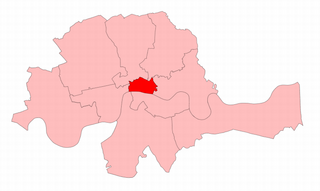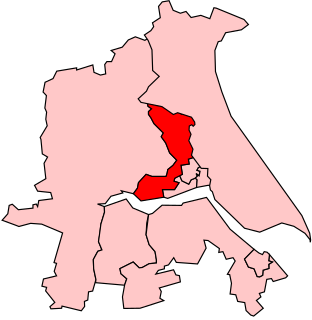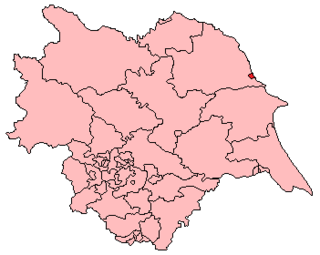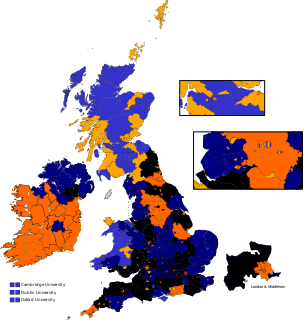Bedfordshire was a United Kingdom Parliamentary constituency, which elected two Members of Parliament from 1295 until 1885, when it was divided into two constituencies under the Redistribution of Seats Act 1885.
Middlesex was a constituency of the House of Commons of the Parliament of England, then of the Parliament of Great Britain from 1707 to 1800, then of the Parliament of the United Kingdom from 1801 until abolished in 1885. It returned two members per election by various voting systems including hustings.

The City of London was a United Kingdom Parliamentary constituency. It was a constituency of the House of Commons of the Parliament of England then of the Parliament of Great Britain from 1707 to 1800 and of the Parliament of the United Kingdom from 1801 to 1950.
Ripon was a constituency sending members to the House of Commons of the Parliament of the United Kingdom until 1983, centred on the city of Ripon in North Yorkshire.

Beverley has been the name of a parliamentary constituency in the East Riding of Yorkshire for three periods. From medieval times until 1869 it was a parliamentary borough consisting of a limited electorate of property owners of its early designated borders within the market town of Beverley, which returned (elected) two Members of Parliament to the House of Commons of the English and Welsh-turned-UK Parliament during that period.
Bradford was a parliamentary constituency in Bradford, in the West Riding of Yorkshire.

Scarborough was the name of a constituency in Yorkshire, electing Members of Parliament to the House of Commons, at two periods. From 1295 until 1918 it was a parliamentary borough consisting only of the town of Scarborough, electing two MPs until 1885 and one from 1885 until 1918. In 1974 the name was revived for a county constituency, covering a much wider area; this constituency was abolished in 1997.
Malton, also called New Malton, was a constituency of the House of Commons of the Parliament of England in 1295 and 1298, and again from 1640, then of the Parliament of Great Britain from 1707 to 1800 and of the Parliament of the United Kingdom from 1801 to 1885. It was represented by two Members of Parliament until 1868, among them the political philosopher Edmund Burke, and by one member from 1868 to 1885.

West Riding of Yorkshire was a parliamentary constituency in England from 1832 to 1865. It returned two Members of Parliament (MPs) to the House of Commons of the Parliament of the United Kingdom.
Pontefract was an English parliamentary constituency centred on the town of Pontefract in the West Riding of Yorkshire, which returned two Members of Parliament to the House of Commons briefly in the 13th century and again from 1621 until 1885, and one member from 1885 to 1974.

East Riding of Yorkshire was a parliamentary constituency covering the East Riding of Yorkshire, omitting Beverley residents save a small minority of Beverley residents who also qualified on property grounds to vote in the county seat. It returned two Members of Parliament to the House of Commons of the Parliament. A brief earlier guise of the seat covered the changed franchise of the First Protectorate Parliament and Second Protectorate Parliament during a fraction of the twenty years of England and Wales as a republic.

North Riding of Yorkshire was the constituency of the North Riding of Yorkshire. It returned two Members of Parliament to the House of Commons of the Parliament of the United Kingdom.
Bristol was a two-member constituency, used to elect members to the House of Commons in the Parliaments of England, Great Britain (1707–1800) and the United Kingdom. The constituency existed until Bristol was divided into single member constituencies in 1885.
Thirsk was a parliamentary borough in Yorkshire, represented in the English and later British House of Commons in 1295, and again from 1547. It was represented by two Members of Parliament until 1832, and by one member from 1832 to 1885, when the constituency was abolished and absorbed into the new Thirsk and Malton division of the North Riding of Yorkshire.
Northallerton was a parliamentary borough in the North Riding of Yorkshire, represented by two Members of Parliament in the House of Commons briefly in the 13th century and again from 1640 to 1832, and by one member from 1832 until 1885.
Knaresborough was a parliamentary constituency which returned two Members of Parliament (MPs) to the House of Commons of the Parliament of the United Kingdom until 1868, and then one MP until its abolition in 1885.
New Shoreham, sometimes simply called Shoreham, was a parliamentary borough centred on the town of Shoreham-by-Sea in what is now West Sussex. It returned two Members of Parliament (MPs) to the House of Commons of England from 1295 to 1707, then to the House of Commons of Great Britain until 1800, and finally to the House of Commons of the Parliament of the United Kingdom from 1801 until it was abolished by the Redistribution of Seats Act 1885, with effect from the 1885 general election.
East Worcestershire was a county constituency in the county of Worcestershire, represented in the House of Commons of the Parliament of the United Kingdom.
Stoke-upon-Trent was a parliamentary borough in Staffordshire, which elected two Members of Parliament (MPs) to the House of Commons from 1832 until 1885, and then one member from 1885 until 1918, when the borough was enlarged, renamed Stoke-on-Trent, and split into three single-member constituencies.
Tynemouth and North Shields was a parliamentary constituency represented in the House of Commons of the Parliament of the United Kingdom between 1832 and 1885. It elected one Member of Parliament (MP) by the first-past-the-post system of election.




